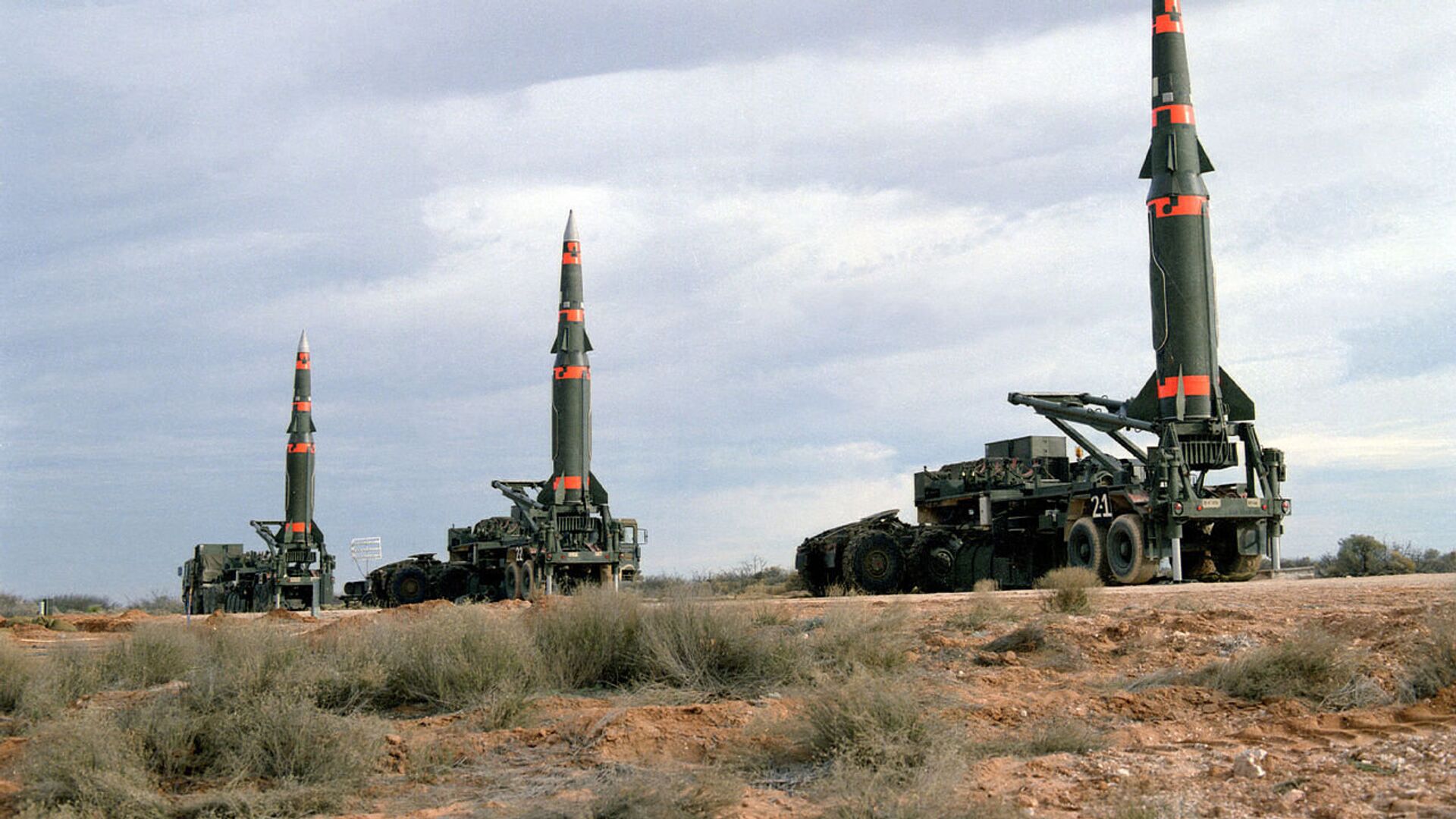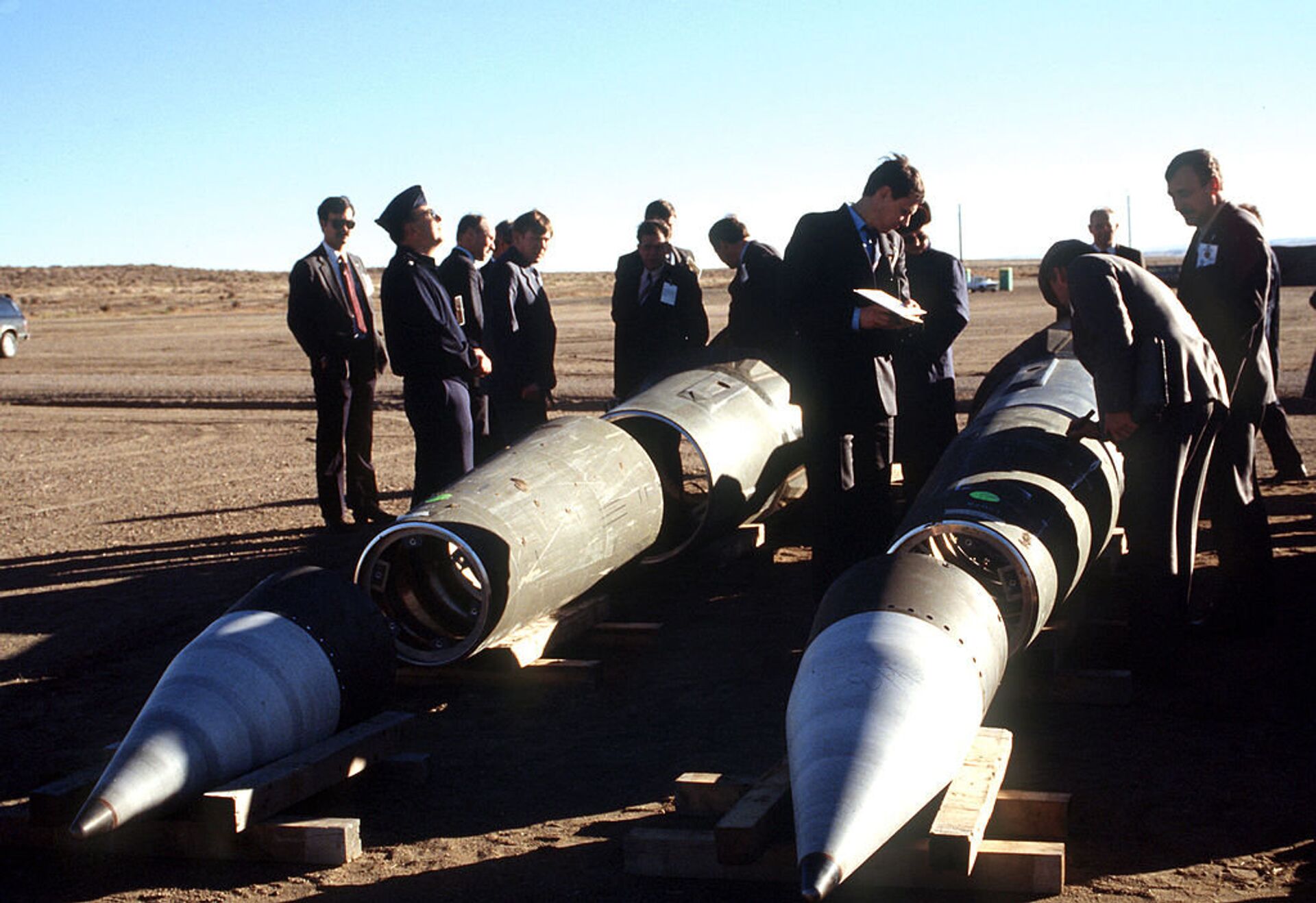US Systematically Removed Trust, Transparency Safeguards Preventing Nuclear War, Ignores Remainder
23:33 GMT 28.01.2022 (Updated: 13:28 GMT 06.08.2022)

CC0 / /
Subscribe
During and after the Cold War, when NATO and the Warsaw Pact armies faced each other down, backed by nuclear arsenals, the two sides reached agreements to make war much less likely. However, the US has systematically pulled them apart in its quest to maintain global dominance, making the present situation significantly more dangerous.
As the US threatens to send thousands of troops to Eastern Europe, joining an already-boosted Enhanced Forward Presence by the NATO alliance, claiming it needs to deter an imminent Russian invasion of Ukraine, it is proving inflexible toward any defense considerations of Russia, on whose border several NATO members sit.
The situation has Russian leaders, who have patiently and publicly articulated their concerns in Eastern Europe as a way to resolve the present crisis, flummoxed. The US has demanded Russia pull its troops back from parts of Russian territory near the Ukrainian border, claiming they pose an inherent threat to Ukraine. However, Moscow has denied any intent to invade, saying its troops are engaged in drills and asserting its sovereign right to send soldiers anywhere on its territory. Ironically, Ukrainian leaders have also downplayed US claims that an invasion threat exists.
The situation is so volatile because of years of building tension in the region, while at the same time, many of the safeguards intended to keep tensions and suspicions low have been removed or ignored by the United States.
1972 Anti-Ballistic Missile (ABM) Treaty
The first blow was struck in 2001, when then-US President George W. Bush unilaterally pulled the US out of the ABM treaty, which limited the US and Russia - the Soviet Union when the treaty was signed - to two complexes of ballistic missile interceptors.
It had been feared in the early 1970s that recent technological developments, such as multiple independent reentry vehicles (MIRV), could provoke a dangerous arms race in which a nuclear first strike might seem like the advantageous option for a nation with such a defensive network. By limiting defensive measures to a set of interceptors around the capital city and another around a complex of intercontinental ballistic missile (ICBM) silos, the US and USSR believed the threat of war was diminished.

The Ground-based Midcourse Defense (GMD) element of the U.S. ballistic missile defense system launches during a flight test from Vandenberg Air Force Base, California, U.S
© REUTERS / Lucy Nicholson
Bush claimed the treaty had left the US vulnerable to attack and created the Missile Defense Agency at the Pentagon to oversee a new generation of air defense systems, such as the Terminal High Altitude Area Defense (THAAD), Patriot PAC-3, and Ground-Based Midcourse Defense. However, just 18 months prior, then-US President Bill Clinton had joined Russian President Vladimir Putin in calling the ABM Treaty the “cornerstone of strategic stability.”
As predicted, the treaty’s removal sparked an arms race, with Moscow dusting off old plans for hypersonic weapons, which it unveiled in 2017, in order to compensate for Washington’s dramatically increased protection from ballistic missile attack.
2002 Treaty of Moscow/ New START (Almost)
The Treaty Between the United States of America and the Russian Federation on Strategic Offensive Reductions (SORT), also called simply the Treaty of Moscow, was a simple arms limitation treaty. Russia and the United States agreed to limit their nuclear arsenals to between 1,700 and 2,200 operationally deployed warheads each.
The deal had many faults, including that no warheads were destroyed, meaning they could be put into storage and then unpacked in 2012, when the treaty expired - and expire it did, albeit also being superseded by the New Strategic Arms Reduction Treaty (New START) in 2011. New START called for halving the number of strategic nuclear missile launchers and established a new inspection and verification regime, although it also did not get rid of the storage loophole.
The administration of former US President Donald Trump fully intended for New START to die when it expired in February 2021, but after he lost the November 2020 election to US President Joe Biden, a new leader came into office just weeks before the expiration and renewed it for another five years.
1987 Intermediate-Range Nuclear Forces (INF) Treaty
Similarly to the ABM Treaty, the US unilaterally pulled out of the INF Treaty in 2019. However, instead of simply stating it wished to develop weapons beyond the treaty’s limitations, the Trump administration accused Moscow of violating the treaty by lying about the range of its 9M728/9M729 missiles used by the Iskander missile system. Nonetheless, within two weeks of the US’ formal departure from the treaty in August 2019, it began testing the first of multiple missiles that violated the treaty’s limitations.
The origins of the INF Treaty lay in a dramatic showdown across Europe in late 1983, triggered by Washington’s deployment of Pershing-II intermediate-range ballistic missiles (IRBM) to Europe. With a 900-mile range, a flight apogee of just 60 miles, and a maneuverable, radar-guided reentry vehicle, the missile could put an 80-kiloton nuclear warhead on Moscow in between six and 11 minutes, according to Pentagon leaders. Such a fast strike time gave the Soviets just minutes to identify, analyze and respond to the threat, greatly increasing the risk of them misreading a situation and launching a mistaken nuclear return volley, believing it to be their only chance.

Soviet inspectors and their American escorts stand among several dismantled Pershing II missiles as they view the destruction of other missile components
CC0 / /
In addition, tensions in Europe had already been ramped up by years of psychological operations designed to increase Soviet anxieties, such as US bombers charging Soviet borders and turning away at the last second
That’s why, when NATO began the vast, ultra-realistic “Able Archer-83” war games simulating an all-out attack on the Soviet Union in November 1983, it put Soviet fears through the roof. However, it wasn’t until after the war games had concluded several days later that NATO commanders discovered key signs the Soviets had loaded hundreds of strike aircraft in East Germany and Poland with nuclear bombs and orders to strike “front-line targets” at a moment’s notice.
The INF Treaty eliminated missiles like the Pershing-II, banning land-based missiles with ranges of between 500 kilometers and 5,500 kilometers. This significantly cooled tensions in Europe, although the treaty was only between the US and Soviet Union - now Russia - which left other countries, such as China, free to develop their own intermediate-range missiles.
The INF’s absence now is especially poignant considering long-standing Russian fears over a NATO Aegis Ashore missile system built on a land base in Deveselu, Romania. While the US claimed the system was purely defensive, Moscow noted that Aegis can also be used to launch offensive missiles. Among the missiles tested after the INF Treaty lapsed was a land-based Tomahawk missile with a range of 1,600 kilometers - a cruise missile US Aegis cruisers have fired at sea for years.
1992 Treaty on Open Skies
The Open Skies treaty was an attempt to increase transparency and put to rest fears of an impending attack by the other side. The deal allowed 35 partner nations to perform reconnaissance overflights over other nations using specialized aircraft with specialized equipment. However, flights could not interfere with other military activities and could be refused by the overflown nation for a variety of reasons.
The US sent signs it was interested in leaving the treaty as early as 2019, claiming it was caused by Russia refusing US Open Skies aircraft access to several areas almost a decade earlier - denials Moscow insisted were within its rights under the treaty. The US finally made the move on May 21, 2020, meaning the six-month cooldown time had the US leaving the treaty after the November 2020 elections that Trump lost.
The decision sparked outcry across Europe, with Ukraine being one of the loudest critics; that nation having long used Open Skies to perform overflights in western Russia to calm its nerves about troops and installations there. Indeed, the Open Skies Treaty was drafted precisely to avoid the type of anxious confrontation unfolding on the Russia-Ukraine border over the last two months.
The Democrats publicly attacked Trump’s withdrawal as illegal at the time, although much of their criticism focused on his refusal to notify Congress before pulling out. However, in March 2021, a leaked message sent to concerned “international partners” by the Democratic Biden administration said it was afraid that doing so “would send the wrong message to Russia and undermine our position on the broader arms control agenda.”

A Boeing OC-135B Open Skies aircraft - the type used in this week's US-Ukrainian overflight over Russia.
CC0 / /
Istanbul, Astana Declarations
The Organization for Security and Cooperation in Europe (OSCE) has its origins in the November 1972 multilateral talks in Espoo, Finland, intended to further the peaceful cooperation of the Detente era. Today, the OSCE has 57 members and 11 observers and continues to serve as a regional forum for resolving international issues.
Two of its most important declarations of principles came at summits in Istanbul, Turkey, in 1999 and in Astana (now Nur-Sultan), Kazakhstan, in 2010, which, among other topics, affirmed each nation’s right to its own security in the context of an international community.
"The security of each participating State is inseparably linked to that of all others. Each participating State has an equal right to security. We reaffirm the inherent right of each and every participating State to be free to choose or change its security arrangements, including treaties of alliance, as they evolve. Each State also has the right to neutrality. Each participating State will respect the rights of all others in these regards. They will not strengthen their security at the expense of the security of other States,” the Astana declaration states.
While the OSCE met in Vienna, Austria, two weeks ago, the talks yielded no major breakthrough. Earlier this week, when the US and NATO delivered separate written responses to Russia’s December security proposal, the American response was considerably more intransigent, while NATO’s, sent from Brussels and speaking for 30 member states, acknowledged Russian security concerns and proposed mutual briefings in the NATO-Russia Council and the reestablishment of their respective envoys in Moscow and Brussels.
However, neither reply gave deference to Russia’s central concern: the eastward expansion of NATO and the impact that has on Russian security, especially since now the US explicitly regards Russia as a challenger to its position as leader of the post-Cold War global order.
Speaking on Thursday about the American response, in particular, Russian Foreign Minister Sergey Lavrov said: "The principle that one should not strengthen one's security at the expense of the security of others is deliberately avoided. Neither the Istanbul nor the Astana declarations are mentioned by our Western partners in the discussions on European security that are currently taking place … We cannot accept this.”



